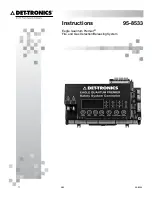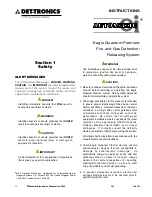
7.1
95-8533
2-6
During normal operation one controller acts as the
“Master” while the other acts as the “Hot Standby”.
Terminology used for redundancy:
master controller
This is the normal mode for
non-redundant and master
controllers. User logic is
executed, outputs are being
controlled and all serial ports
are active.
standby controller
This controller is receiving all
inputs but does not have any
control over the outputs and
user logic is not executed. The
standby controller receives
update information from the
master controller to ensure a
bumpless transfer should a
controller switchover occur.
primary controller
T h e co n t ro ll e r as s i gn e d
address 1.
secondary controller
T h e co n t ro ll e r as s i gn e d
address 2.
Bumpless transfer
During a controller switchover
no change in output will occur
due to the switchover.
serial interface Board
An optional serial board is available that supports up
to four additional serial ports. See Table 2-4. For a
redundant controller configuration, the board is
required in both controllers.
Controller-to-Controller Communication (sLC485)
The EQP controllers can be configured to
communicate with up to 12 controllers via RS-485
communication. The controller-to-controller scheme
provides the ability to meet NFPA 72 SLC requirements
with the following primary features:
• Modular trouble and alarm configuration
• Multiple zone application with controller-to-controller
communication
• Multiple media options.
EQp supervising system (EQpss)
The Det-Tronics EQP controllers can be supervised
via the EQPSS using PCs and HMI. Each EQPSS PC
can communicate with up to 12 EQP controllers over
an Ethernet. This is a Det-Tronics solution. Please
consult the factory for more information.
EQp marine application system
For information regarding EQP Marine Application
Systems, refer to Appendix D.
LoCaL opERatinG nEtWoRK (Lon)
The LON is a fault tolerant, two wire, digital
communication network. The circuit is arranged in a
loop starting and ending at the Controller. The circuit
supports up to 246 intelligent field devices spread
over a distance of up to 10,000 meters (32,500 feet).
note
All Lon devices support AnSI/nFPA 72 Class A,
Style 7 communication with the Controller.
network Extenders
Transmitted signals can travel a maximum distance of
2,000 meters through LON communication wire. At
the end of this distance, a network extender (see
Figure 2-7) must be installed to rebroadcast the
communications into the next wire segment. For
every network extender added, the length of the
communications loop extends up to 2,000 meters.
Due to propagation delays around the loop, the
maximum loop length is limited to 10,000 meters.
noteS
A n e t wo r k ex te n d e r i s re q u i re d fo r
communication loops greater than 60 nodes.
port name
Comm Function
Serial Port 2
RS485 ModBus (Master/Slave)
Ground Fault Monitored,
Isolated
Serial Port 3
RS232 ModBus (Master/Slave)
S3 Configuration
Serial Port 4
RS232 ModBus (Master/Slave)
HSSL Redundancy RS232 Redundant Controller to
Port
Controller Only
Table 2-4—Ports on Optional Serial Interface Board
Содержание DET-TRONICS 95-8533
Страница 1: ...Instructions 95 8533 Eagle Quantum Premier Fire and Gas Detection Releasing System 7 1 9 09 95 8533 ...
Страница 128: ...7 1 95 8533 A 4 Figure A 1 System Drawing 007545 001 ...
Страница 129: ...95 8533 A 5 7 1 Figure A 2 System Drawing 007545 001 ...
Страница 131: ...95 8533 7 1 B 2 Figure B 1 Drawing 007546 001 ...
Страница 132: ...95 8533 7 1 B 3 Figure B 2 Drawing 007546 001 ...
Страница 134: ...95 8533 7 1 C 2 Figure C 1 Drawing 007547 001 ...
Страница 141: ...95 8533 7 1 D 7 Figure D1 System Drawing 007545 001 ...
Страница 143: ...APPENDIX E E 1 95 8533 7 1 ...













































